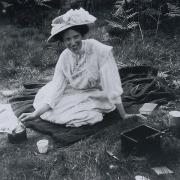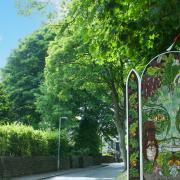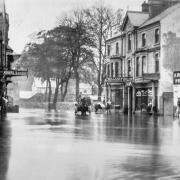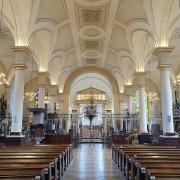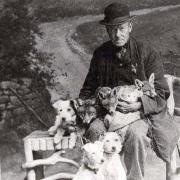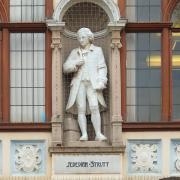As we’ve discovered so far in this series, Derbyshire is a county with a number of ‘firsts’ to its name.
Perhaps one of the least known is the factory of John Smedley and Sons at Lea Mills, near Matlock, which is the world’s oldest manufacturing works, and has been in continuous operation for nearly 240 years.
Today, of course, John Smedley is renowned throughout the world as a leader in the production of fine knitwear products.
Still family-owned, the company retains the hand-crafted finishing techniques that have established its international reputation for 239 years.
John Smedley senior and associate Peter Nightingale (Florence Nightingale’s great great uncle and former accountant to Richard Arkwright) founded the company at Lea Mills in 1784, the year the Treaty of Paris officially established the United States of America as a sovereign nation.
Closer to home, in the same year the natural philosopher and scientist Henry Cavendish, son of the 2nd Duke of Devonshire, discovered hydrogen, which he called ‘inflammable air.’

Lea Bridge provided an ideal setting for the mill, as the Lea Brook that ran through the village provided a constant source of running water to both clean yarn and power the mill’s machinery.
John Smedley was the name of four generations of owners of Lea Mills. The most famous being John Smedley (1803–1874), born at Wirksworth.
In its early days the mill specialised in the production of muslin and spinning cotton sent out to local cottagers using their hand frame looms.
Towards the end of the 18th century the company had extended its activities to include knitting and hosiery manufacture, by which time John Smedley was running the business alone, although the Nightingale family still retained an interest.
In 1819, John Smedley’s son John was apprenticed to the company and, after years of meticulous training from his father, took over the helm six years later at the tender age of 24.

With great energy and vision, John II set about modernising and expanding, with the stated intention that all the manufacturing processes required to produce finished product should be under one roof, using the finest quality raw materials available.
According to the company’s publicity statements, these principles continue to be the cornerstone of the company’s success.
A growing and dedicated workforce was established, and indeed younger generations of original John Smedley workers can still be found at the factory even today.
The younger John Smedley married Caroline Harward, the second daughter of John Harward, the vicar of Wirksworth in 1847.
Smedley took a keen interest in hydropathy – the treatment of illness by water. In 1851 and 1852, accompanied by Caroline, Smedley travelled to Dr William Macleod’s Ben Rhydding Hydro, near Ilkley in West Yorkshire, for nine weeks and three months respectively.
Smedley was so impressed with the hydropathic treatment, together with the ‘religious zeal’ of Macleod, that he decided to introduce hydropathy to his own workforce.
But while the treatment seems to have had a beneficial effect on Smedley’s physical condition, it apparently did not alleviate his spiritual or mental state.
His response was to embark on another trip to Cheltenham Spa, where Smedley purchased the Rose Hill estate. From there, he sent letters to his workers back in Derbyshire, who held prayer meetings on his behalf.
Smedley opted for a ‘simple humble life’, renouncing all ‘frivolity and extravagance.’ He had always been a religious man, but believed it was this new nonconformist religious cause, with Caroline’s support, which had restored him to health.
Smedley built a number of chapels around Lea Mills in the early 1850s, including his own nonconformist building at Holloway, and chapels for the Cromford Wesleyan Reform circuit at Bonsall, Birchwood-by-Alfreton, Ashover and Higham.
In addition, he bought a marquee used to preach at local venues and also financed the building of a number of schools.
Continuing his interest in hydrotherapy, he lost no time in bringing the treatment to Lea Bridge, opening a free hospital for up to six patients in Post Office Row, close to his mill, in 1851, which was initially for the benefit of his workforce and later for other local people.
He continued to develop his interest in hydrotherapy and in 1852 established the Smedley Hydro in Matlock - since the 1950s, the offices of Derbyshire County Council.
This was the first and largest spa resort in Matlock, which attracted patrons from around the world. At the time, it was one of 25 hydros in Matlock, offering a variety of different baths and water treatments.
A cable tramway was built to take passengers between the railway station and Smedley’s Hydro. It ran from March 1893 to September 1927 and, according to the 1908 Kelly's Directory, was the steepest tramway in the world on public roads, featuring a 1 in 5½ (18 per cent) grade slope.

Smedley also built the ostentatious, mock-Gothic Riber Castle on an 850-foot hilltop overlooking Matlock as a family home. How he reconciled this with his previous denouncement on all ‘frivolity and extravagance’ is unrecorded.
The huge mansion, with its four castellated corner towers and 20 bedrooms, was constructed between 1862 and 1868.
Following the death of John Smedley in July 1875, Caroline continued to live at Riber Castle until her death in 1892.
The castle was later used as a school (between 1894-1929) and as a wartime food store. After a period of dereliction, the now ruinous premises became a wildlife park before a new owner began a rebuild within the original shell.
Still a roofless ruin, Riber Castle is one of Derbyshire’s most famous landmarks, visible for miles around, but its future remains uncertain.
John Smedley had no heir on his death, so the business passed to a third John, his cousin John T Marsden-Smedley, who after his death in 1877 entrusted the company to his son, the fourth John B Marsden-Smedley.
John Smedley IV took the company expansion even further, remaining chairman for an impressive 70 years.
During this time, he installed up-to-the-minute knitting machines and took the decision to become a limited company in 1893, producing more versatile garments, such as underwear and knitted outerwear.
It has been claimed that Smedley’s were responsible for the origin of the full-length under pants known as Long Johns.
Over the next 50 years, the company extended its underwear production to incorporate swimwear and nightwear for men and women.
During the 1960s, the signature John Smedley sweater line was developed, which became responsible for the growth of the company into overseas markets.
In the 1960s, John Smedley augmented their relationship with the British Royal family, hosting the late Queen Elizabeth II on a tour of Lea Mills, giving her an insight into how her favourite knitwear was produced.
Following this visit, it became known that John Smedley was the official knitwear supplier to the Queen.
Lea Mills remains open and operational today, manufacturing the company’s iconic range of designer knitwear. In fact, John Smedley claims to be the world’s longest running factory manufacturer.
The John Smedley label is now familiar in boutiques, department stores and classic retailers all around the world. It sells to over 30 countries and has won numerous awards for its export achievements, the largest export market being Japan.
NEXT MONTH: Roly recounts the story of the ‘Lady with the Lamp’, Holloway’s pioneer of modern nursing, Florence Nightingale.








